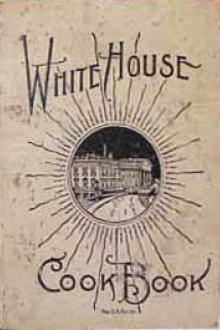The Whitehouse Cookbook (1887), Hugo Ziemann [world of reading .TXT] 📗

- Author: Hugo Ziemann
- Performer: -
Book online «The Whitehouse Cookbook (1887), Hugo Ziemann [world of reading .TXT] 📗». Author Hugo Ziemann
SCALLOPED CHEESE.
Any person who is fond of cheese could not fail to favor this recipe.
Take three slices of bread well-buttered, first cutting off the brown outside crust. Grate fine a quarter of a pound of any kind of good cheese; lay the bread in layers in a buttered baking-dish, sprinkle over it the grated cheese, some salt and pepper to taste. Mix four well-beaten eggs with three cups of milk; pour it over the bread and cheese. Bake it in a hot oven as you would cook a bread pudding. This makes an ample dish for four people.
PASTRY RAMAKINS.
Take the remains or odd pieces of any light puff paste left from pies or tarts; gather up the pieces of paste, roll it out evenly, and sprinkle it with grated cheese of a nice flavor. Fold the paste in three, roll it out again, and sprinkle more cheese over; fold the paste, roll it out, and with a paste-cutter shape it in any way that may be desired. Bake the ramakins in a brisk oven from ten to fifteen minutes; dish them on a hot napkin and serve quickly. The appearance of this dish may be very much improved by brushing the ramakins over with yolk of egg before they are placed in the oven. Where expense is not objected to, parmesan is the best kind of cheese to use for making this dish.
Very nice with a cup of coffee for a lunch.
CAYENNE CHEESE STRAWS.
A quarter of a pound of flour, two ounces butter, two ounces grated parmesan cheese, a pinch of salt and a few grains of cayenne pepper. Mix into a paste with the yolk of an egg. Roll out to the thickness of a silver quarter, about four or five inches long; cut into strips about a third of an inch wide, twist them as you would a paper spill and lay them on a baking-sheet slightly floured. Bake in a moderate oven until crisp, but they must not be the least brown. If put away in a tin these straws will keep a long time. Serve cold, piled tastefully on a glass dish. You can make the straws of remnants of puff pastry, rolling in the grated cheese.
CHEESE CREAM TOAST.
Stale bread may be served as follows: Toast the slices and cover them slightly with grated cheese; make a cream for ten slices out of a pint of milk and two tablespoonfuls of plain flour. The milk should be boiling, and the flour mixed in a little cold water before stirring in. When the cream is nicely cooked, season with salt and butter; set the toast and cheese in the oven for three or four minutes and then pour the cream over them.
WELSH RAREBIT.
Grate three ounces of dry cheese and mix it with the yolks of two eggs, put four ounces of grated bread and three of butter; beat the whole together in a mortar with a dessertspoonful of made mustard, a little salt and some pepper; toast some slices of bread, cut off the outside crust, cut it in shapes and spread the paste thick upon them, and put them in the oven, let them become hot and slightly browned, serve hot as possible.
There are so many ways of cooking and dressing eggs, that it seems unnecessary for the ordinary family to use those that are not the most practical.
To ascertain the freshness of an egg, hold it between your thumb and forefinger in a horizontal position, with a strong light in front of you. The fresh egg will have a clear appearance, both upper and lower sides being the same. The stale egg will have a clear appearance at the lower side, while the upper side will exhibit a dark or cloudy appearance.
Another test is to put them in a pan of cold water; those that are the first to sink are the freshest; the stale will rise and float on top; or, if the large end turns up in the water, they are not fresh. The best time for preserving eggs is from July to September.
TO PRESERVE EGGS.
There are several recipes for preserving eggs and we give first one which we know to be effectual, keeping them fresh from August until Spring. Take a piece of quick-lime as large as a good-sized lemon and two teacupfuls of salt; put it into a large vessel and slack it with a gallon of boiling water. It will boil and bubble until thick as cream; when it is cold, pour off the top, which will be perfectly clear. Drain off this liquor, and pour it over your eggs; see that the liquor more than covers them. A stone jar is the most convenient—one that holds about six quarts.
Another manner of preserving eggs is to pack them in a jar with layers of salt between, the large end of the egg downward, with a thick layer of salt at the top; cover tightly and set in a cool place.
Some put them in a wire basket or a piece of mosquito net and dip them in boiling water half a minute; then pack in sawdust. Still another manner is to dissolve a cheap article of gum arabic, about as thin as muscilage, and brush over each egg with it; then pack in powdered charcoal; set in a cool, dark place.
Eggs can be kept for some time by smearing the shells with butter or lard; then packed in plenty of bran or sawdust, the eggs not allowed to touch one another; or coat the eggs with melted paraffine.
BOILED EGGS.
Eggs for boiling cannot be too fresh, or boiled too soon after they are laid; but rather a longer time should be allowed for boiling a new-laid egg than for one that is three or four days old. Have ready a saucepan of boiling water; put the eggs into it gently with a spoon, letting the spoon touch the bottom of the saucepan before it is withdrawn, that the egg may not fall and consequently crack. For those who like eggs lightly boiled, three minutes will be found sufficient; three and three-quarters to four minutes will be ample time to set the white nicely; and if liked hard, six or seven minutes will not be found too long. Should the eggs be unusually large, as those of black Spanish fowls sometimes are, allow an extra half minute for them. Eggs for salad should be boiled for ten or fifteen minutes, and should be placed in a basin of cold water for a few minutes to shrink the meat from the shell; they should then be rolled on the table with the hand and the shell will peel off easily.
SOFT BOILED EGGS.
When properly cooked eggs are done evenly through, like any other food. This result may be obtained by putting the eggs into a dish with a cover, or a tin pail, and then pouring upon them boiling water—two quarts or more to a dozen of eggs—and cover and set them away where they will keep hot and not boil for ten to twelve minutes. The heat of the water cooks the eggs slowly, evenly and sufficiently, leaving the centre or yolk harder than the white, and the egg tastes as much richer and nicer as a fresh egg is nicer than a stale egg.
SCALLOPED EGGS.
Hard-boil twelve eggs; slice them thin in rings; in the bottom of a large well-buttered baking-dish place a layer of grated bread crumbs, then one of eggs; cover with bits of butter and sprinkle with pepper and salt. Continue thus to blend these ingredients until the dish is full; be sure, though, that the crumbs cover the eggs upon top. Over the whole pour a large teacupful of sweet cream or milk and brown nicely in a moderately heated oven.
SHIRRED EGGS.
Set into the oven until quite hot a common white dish large enough to hold the number of eggs to be cooked, allowing plenty of room for each. Melt in it a small piece of butter, and breaking the eggs carefully in a saucer, one at a time, slip them into the hot dish; sprinkle over them a small quantity of pepper and salt and allow them to cook four or five minutes. Adding a tablespoonful of cream for every two eggs, when the eggs are first slipped in, is a great improvement.
This is far more delicate than fried eggs.
Or prepare the eggs the same and set them in a steamer over boiling water.
They are usually served in hotels baked in individual dishes, about two in a dish, and in the same dish they were baked in.
SCRAMBLED EGGS.
Put a tablespoonful of butter into a hot frying pan; tip around so that it will touch all sides of the pan. Having ready half a dozen eggs broken in a dish, salted and peppered, turn them (without beating) into the hot butter; stir them one way briskly for five or six minutes or until they are mixed. Be careful that they do not get too hard. Turn over toast or dish up without.
POACHED OR DROPPED EGGS.
Have one quart of boiling water and one tablespoonful of salt in a frying pan. Break the eggs, one by one, into a saucer, and slide carefully into the salted water. Dash with a spoon a little water over the egg, to keep the top white.
The beauty of a poached egg is for the yolk to be seen blushing through the white, which should only be just sufficiently hardened to form a transparent veil for the egg.
Cook until the white is firm, and lift out with a griddle cake turner and place on toasted bread. Serve immediately.
A tablespoonful of vinegar put into the water keeps the eggs from spreading.
Open gem rings are nice placed in the water and an egg dropped into each ring.
FRIED EGGS.
Break the eggs, one at a time, into a saucer, and then slide them carefully off into a frying pan of lard and butter mixed, dipping over the eggs the hot grease in spoonfuls, or turn them over, frying both sides without breaking them. They require about three minutes' cooking.
Eggs can be fried round like balls, by dropping one at a time into a quantity of hot lard, the same as for fried cakes, first stirring the hot lard with a stick until it runs round like a whirlpool; this will make the eggs look like balls. Take out with a skimmer. Eggs can be poached the same in boiling water.
EGGS AUX FINES HERBES.
Roll an ounce of butter in a good teaspoonful of flour; season with pepper, salt and nutmeg; put it into a coffeecupful of fresh milk, together with two teaspoonfuls of chopped parsley; stir and simmer it for fifteen minutes, add a teacupful of thick cream. Hard-boil five eggs and halve them; arrange them in a dish with the ends upwards, pour the sauce over them, and decorate with little heaps of fried bread crumbs round the margin of the dish.
POACHED EGGS Á LA CRÊME.
Put a quart of hot water, a tablespoonful of vinegar and a teaspoonful of salt into a frying pan, and break each egg separately into a saucer; slip the egg carefully into the hot water, simmer three or four minutes until the white is set, then with a skimmer lift them out into a hot dish. Empty the pan





Comments (0)